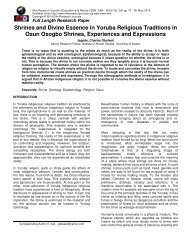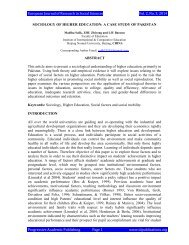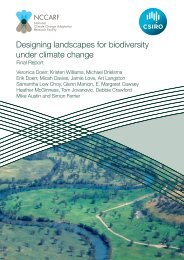Williams-Climate-change-refugia-for-terrestrial-biodiversity_0
Williams-Climate-change-refugia-for-terrestrial-biodiversity_0
Williams-Climate-change-refugia-for-terrestrial-biodiversity_0
You also want an ePaper? Increase the reach of your titles
YUMPU automatically turns print PDFs into web optimized ePapers that Google loves.
lower deviance explained) at a site was selected. This ensured more sites were<br />
available <strong>for</strong> site-pair sampling.<br />
Environmental variables<br />
A common set of environmental variables were developed and tested as candidate<br />
predictors in GDM models. The spatial environmental data were compiled from best<br />
available sources and resampled to a common resolution (9-second, 3-second). As<br />
described in Supporting In<strong>for</strong>mation 3 (Harwood et al., terrain scaling) relevant climatic<br />
variables were adjusted <strong>for</strong> local topography using a scaling factor derived from using<br />
the r.sun routine in GRASS GIS (GRASS Development Team, 2011) with the<br />
respective DEM. Representative monthly estimates of radiation relative to an<br />
unshaded horizontal surface were obtained <strong>for</strong> the 15 th day. This ratio was used to<br />
adjust monthly incoming shortwave radiation, net radiation, maximum temperature and<br />
potential evaporation following the procedures in Wilson and Gallant (2000) and Allen<br />
et al. (1998). The topographic adjustments were then propagated throughout relevant<br />
climate predictors.<br />
For the 3-second gridded predictors, a 3-second digital elevation model, available as a<br />
derivative of the 1-second corrected and smoothed SRTM DEM (Gallant, 2011), was<br />
used with ANUCLIM version 6.1 software (Xu & Hutchinson, 2011) to derive monthly<br />
climate variables, representing 30 year averages centred on 1990, that were then used<br />
to generate a series of climate predictors (described in <strong>Williams</strong> et al., 2012). The<br />
climatic predictors describe minimum and maximum monthly conditions and different<br />
facets of seasonality associated with temperature and water availability (Supporting<br />
Table 1).<br />
A series of primary and secondary derivatives of the 3-second smoothed and<br />
hydrologically-en<strong>for</strong>ced DEM, developed by J. Gallant and co-workers (Supporting<br />
Table 1) were compiled as supplementary land<strong>for</strong>m predictors, where these are<br />
independent of the climate predictors. In addition to the substrate and land<strong>for</strong>m<br />
variables listed in <strong>Williams</strong> et al. (2012), soil attributes modelled from soil spectra<br />
measurements (Viscarra-Rossel & Chen, 2011, Viscarra Rossel, 2011) and recent<br />
250m gridded (9 second) composite national soil attributes (Jacquier, 2011a, Jacquier,<br />
2011b, Jacquier, 2011c) were also compiled. Furthermore, a composite index of soil<br />
water holding capacity was derived from the topographic wetness index (Gallant et al.,<br />
2012), the soil depth variable derived from the Atlas of Australian soils (Bureau of Rural<br />
Sciences, 2000, McKenzie et al., 2000) and soil water holding capacity (Jacquier,<br />
2011a) using the method described in Claridge et al. (2000).<br />
This compilation of best available, high-resolution climate, land<strong>for</strong>m and substrate<br />
variables resulted in 54 candidate predictors being tested <strong>for</strong> inclusion in the 3-second<br />
GDM models and 61 in the 9-second models (Supporting Table 1).<br />
GDM model fitting<br />
We used the .NET GD Modeller software (Manion, 2012) to develop fitted models of<br />
species compositional turnover. The .NET software has been developed by NSW OEH<br />
<strong>Climate</strong> <strong>change</strong> <strong>refugia</strong> <strong>for</strong> <strong>terrestrial</strong> <strong>biodiversity</strong> 175






